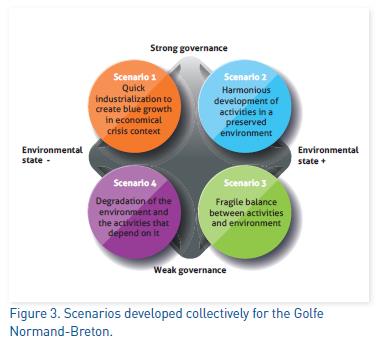The Place and the People we worked with
The Golfe Normand-Breton case study site, stretching from Northeast Brittany to the West of the Cotentin Peninsula, is a vast marine area of over 11,700 km². The rugged seabed and shallow depth of the Golfe, combined with its complex hydrodynamicity make it a natural mosaic of marine habitats. It is sandy-mud sediment for the most part, but dotted with areas of rocky reefs and biogenic habitats. The area includes a multitude of coastal and marine sites of varying protected statuses (e.g. Natura 2000 and Ramsar sites, National Nature Reserves, etc.) and there is a project looking at creating a marine park in the French marine waters.
The VALMER Golfe Normand-Breton team worked with a wide range of stakeholders in the region, including managers of natural areas, representatives of the main leisure and industrial activities as well as representatives of the state and local authorities.
The Process
Our work consists of two interconnected processes:
Marine Ecosystem Services Assessment
In the Golfe Normand-Breton the valuation of ecosystem services was carried out within a broad framework that addressed the need to establish, for the first time, a diagnosis of the state of the wider macro-ecosystem of the ‘Golfe’. Various assessment tools were developed and tested by the project’s scientific team: a map of benthic habitats was produced (Figure 1), and then linked to a “habitats –function” and “habitat-services” matrix (Figure 2); a model for ascertaining a sustainable level of fishing for nine marine species present in the Golfe Normand-Breton and describing fishing fleets’ socio-economic contribution to, an dependence on, the stocks studied; a cumulative impact risk model (InVEST) was used to determine the level of risk on benthic habitats and the services they deliver; and an ecosystem accounting approach highlighting the complex relationship between human activities and ecosystem services of the area.
Building Scenarios
The involvement of local stakeholders was a key element of VALMER project. Taking place over a 15 month period, this approach was based around the building of scenarios in order to foster a collective understanding of complex management issues, enrich each participant’s vision of the marine environment and the ecosystem services it provides, and extend the sphere of concern in order to better anticipate the future. Four exploratory scenarios were developed (Figure 3) as part of dedicated workshops attended by around twenty key local stakeholders from different backgrounds but all with an interest in marine and coastal issues (e.g. politicians, professionals, environmental managers, scientists, public services, associations, users). For this exercise, the scenarios were projected until 2045 and the resulting narratives were combined with the valuation of ecosystem services developed by the VALMER scientific team. These scenarios focused on ecosystem services and leisure food supply related to coastal and marine habitats.
The Results
Initial wide-ranging multidisciplinary diagnosis
Large-scale assessment of ecosystem services in the Golfe Normand-Breton has enabled us to offer an initial diagnosis of the ecosystem services and ecological functions of this area. This wide-ranging, interdisciplinary approach has allowed us to collect quantitative and qualitative information on all ecosystem services in the area, their benefits and the efforts made by society to conserve them. The work went into greater detail on the subjects of food supply and cultural services, which were chosen to be developed as scenarios using the TRIAGE process.
Exploration of four possible futures for the Golfe Normand-Breton and the evolution of its ecosystem services
Having completed this process, the exploration of four different futures for the Golfe Normand-Breton area (Figure 3) has enabled us to consider the evolution of ecosystem services, bringing together the collective scenario-based approach with the current ecosystem service assessment. This exercise has an educational purpose, aiming to stimulate collective reflection on services and the multiple factors which can affect them.
Implications for Governance
Occupying the common ground between ecological, economic and social sciences, the VALMER project has, through its Golfe Normand- Breton case study site, created an opportunity for stakeholders in the area to better identify the range of services provided by the Golfe Normand-Breton and to analyse the challenges which a change to marine ecosystems would represent for the future of certain services. It thus contributes to feeding a collective reflection on the integrated management of the sea. Considerable work has been carried out by environmental managers to compile and compare the results, allowing us to develop methods which are more suitable for purpose and therefore more useful in terms of management. A summary of this project in brochure form could also be distributed among other environmental managers to help them apply the same kind of approach.
For further information on the Golfe Normand-Breton case study please contact Karine Dedieu: karine.dedieu@aires-marines.fr

 English
English  Français
Français 












Comments are currently closed for this case study!